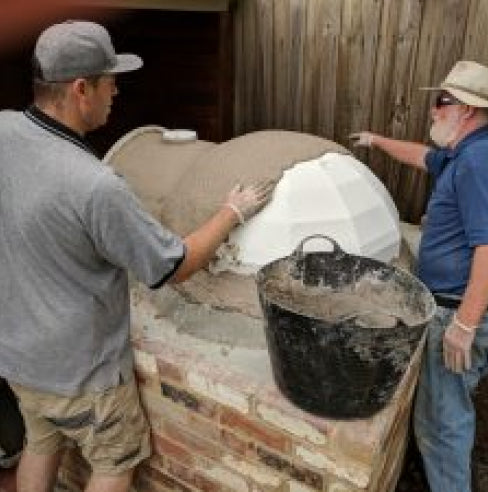FAQ
Everything you need to know to build your DIY wood-fired oven, choose the right mould, and get it done right.
Got Questions About Pizza Oven In A Box?
What Size DIY Pizza Oven Should I Build?
The size you choose depends on your available space, how many people you’re cooking for, and how often you plan to use your oven.
Our most popular sizes are the 800mm and 900mm — they offer the best balance between cooking space and performance.
What’s Included in the Pizza Oven Mould Kit?
Precision-cut, flat-packed cardboard mould
Pre-cut template for the oven door
Easy-to-follow instructions
Strong, simple to assemble, and takes the hard work out of building your wood-fired oven.
What Base or Stand Do I Need for My DIY Pizza Oven?
Your oven will weigh over 500kg once finished, so a solid, level base is essential.
Weight Capacity – Must support the oven, insulation, and finishes
Foundation – Use a concrete slab or well-compacted base to prevent sinking
Materials – Brick, concrete blocks, or precast concrete are ideal
Ventilation – Allow airflow to reduce heat and moisture build-up
Weather Resistance – Choose materials that handle sun, rain, and cold
Accessibility – Make it easy to load, unload, and clean
Style – Match your outdoor area for a clean finished look
What is Refractory Cement for a DIY Wood-Fired Pizza Oven?
Refractory cement is a heat-resistant mix that holds your oven together. It is designed to handle temperatures over 1000°C, making it ideal for pizza ovens.
Key Ingredients to Look For
Alumina (Al₂O₃) – Handles extreme heat
Silica (SiO₂) – Adds strength and workability
Calcium Aluminate – Improves bonding
How Much Refractory Cement Do I Need? (25kg Bags)
700mm mould – 6 bags
800mm mould – 7 bags
900mm mould – 9 bags
1000mm mould – 10 bags
1100mm mould – 12 bags
Tip: Use any excess cement over the outside of the dome for extra strength.
What Tools and Materials Do I Need to Build a Pizza Oven?
Masking Tape – Holds the mould together
Acrylic Paint – Seals cardboard from moisture
6-inch Flue – Improves airflow
Metal Door – Heat retention and access
Ash Pit (Optional) – Easy clean-up
Fire Bricks – Cooking surface
Calcium Silicate Insulation – Heat retention
Refractory Cement – Structural bonding
Fire Cement – Seals gaps
Insulation Blanket or Loose Fill – Dome insulation
Chicken Wire – Outer shell strength
Wire Tie Downs – Holds everything tight
How Long Does It Take to Build a DIY Wood-Fired Pizza Oven?
1–2 Days – Pour slab or foundation
1–2 Days – Build oven base
1 Day – Apply refractory cement
1 Week – Apply outer render
1–2 Weeks – Drying and curing
Several Days to 1 Week – Small curing fires
Why is it important to cure my pizza oven before using it?
Curing removes trapped moisture from the refractory cement. Heating too quickly turns moisture into steam, causing cracking or damage.
Let the oven sit for 7 days after construction. Then begin small fires:
Day 1 – 150°C
Day 2 – 175°C
Day 3 – 200°C
Day 4 – 230°C
Day 5 – 260°C
This ensures safe drying and long-term performance.
How To Mix Refractory Cement
Refractory Cement Suppliers
WHERE TO BUY REFRACTORY CEMENT
Search terms:
Refractory cement
Heat-resistant cement
Furnace / castable cement
Most suppliers below freight Australia-wide.
VIC – MELBOURNE
Refractory Installations / Darley
Oakleigh South
03 9562 6843
mail@refractoryinstallations.com.au
VIC – DANDENONG SOUTH
Radiant Pizza Fire Bricks
03 9791 4433 (Ask for Tim)
1 Elliott Rd, Dandenong South VIC
VIC – WHOLESALE
Consolidated Refractories
0418 368 692
info@conref.com.au
consolidatedrefractories.com.au
NSW – SYDNEY
Field Furnace
02 9729 1799
lee@fieldfurnace.com.au
fieldfurnace.com.au
QLD – BRISBANE
MJP Refractories
0429 151 442
SA – ADELAIDE
Avero
08 8244 5033
WA – PERTH
Darco Industries
08 9418 8826
AUSTRALIA-WIDE (25kg BAGS)
Vitcas – shop.vitcas.com.au
CHT – chtrefractories.com.au
Alsafe – alsafe.com.au


